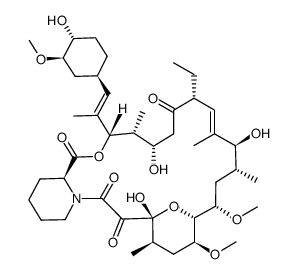L685818
Modify Date: 2024-04-05 18:10:56

L685818 structure
|
Common Name | L685818 | ||
|---|---|---|---|---|
| CAS Number | 143839-74-1 | Molecular Weight | 808.00700 | |
| Density | N/A | Boiling Point | N/A | |
| Molecular Formula | C43H69NO13 | Melting Point | N/A | |
| MSDS | N/A | Flash Point | N/A | |
Use of L685818L685818 is a specific immunophilin ligand. L685818 was neuroregenerative and non-neuroprotective in primary brain cultures. L685818 protects dopaminergic neurons from toxic inhibition of MPP+ and 6-OHDA, reduces tyrosine hydroxylase (TH) loss, and promotes neuronal process regeneration. L685818 is also an antifungal reagent for Cryptococcus neoformans[1][2]. |
| Name | l-685,818 |
|---|---|
| Synonym | More Synonyms |
| Description | L685818 is a specific immunophilin ligand. L685818 was neuroregenerative and non-neuroprotective in primary brain cultures. L685818 protects dopaminergic neurons from toxic inhibition of MPP+ and 6-OHDA, reduces tyrosine hydroxylase (TH) loss, and promotes neuronal process regeneration. L685818 is also an antifungal reagent for Cryptococcus neoformans[1][2]. |
|---|---|
| Related Catalog | |
| In Vitro | L685818 (100 nM; MPP+ 组处理 2 天, 6-OHDA组处理 24 h) 具有神经保护作用,在 MPP+ 和 6-OHDA 抑制下,增加 TH+ 细胞的数目[1]。 L685818 (10-100 nM; 24 h) 防止 MPP+ 和 6-OHDA (HY-B1081) 处理引起的酪氨酸羟化酶 (TH) 损失[1]。 L685818 (0.01-1 μM; 24 h) 防止 MPP+ 和 6-OHDA 导致神经元突起的收缩和丢失,促进突起再生[1]。 |
| References |
| Molecular Formula | C43H69NO13 |
|---|---|
| Molecular Weight | 808.00700 |
| Exact Mass | 807.47700 |
| PSA | 198.59000 |
| LogP | 3.38160 |
| l-685818 |
| l-685818 |